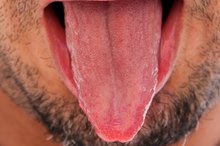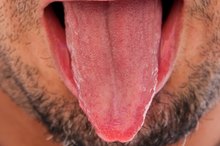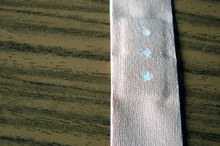How to Heal Tongue Wounds
Tongue wounds are often caused when blows are received to the chin. The teeth bite the tongue and cause cuts and trauma. Due to the vast number of blood vessels present, most tongue wounds heal themselves rather quickly in four to seven days. Deep cuts should be looked at by a doctor. In instances of minor tongue lacerations, patience is key in healing, but you can take measures to avoid infection and speed up healing.
Rinse your mouth to clear any debris that may remain from your accident. Mix 2 tbsp. salt with warm water and rinse for thirty seconds.
How to Stop a Bleeding Tongue
Learn More
Stop bleeding by applying a cold compress. Wrap an ice cube in a towel and press it firmly on your tongue wound for five minutes. To ease swelling, slow bleeding and manage pain, wrap crushed ice in a thin gauze and hold it inside the mouth.
Make your own antiseptic mouthwash to keep the wound clean. Mix one part hydrogen peroxide with one part water and rinse. Do not swallow the mixture, and do not be alarmed if foaming occurs. Hydrogen peroxide foams naturally as it fights the bacteria in your mouth, keeping your tongue wound from getting infected.
How to Cure Cuts Inside Your Lips
Learn More
Make a paste by mixing 1 tsp. baking soda in a little water 2. Apply the mixture to the tongue wound for 5 to 10 minutes. Repeat this method 2 to 3 times a day to reduce pain and protect the wound while it is healing.
Eat a soft, mild diet while your tongue is healing. Avoid spicy or tangy foods and hot temperatures that can irritate your wound. Refrain from foods like chips that can penetrate tongue wounds, as well as caffeine, cigarettes, chocolate and citrus.
See a doctor if the above methods do not help or if your cut is deep, bleeds consistently or is excessively swollen. Your mouth is rife with bacteria, and you may need an antibiotic to ward off infection. Your cut might also require stitches if it is deep enough.
Related Articles
References
- Colgate
- Utah Mountain Biking
- Yoga Wiz
- Kim AM, Keenan BT, Jackson N, et al. Tongue fat and its relationship to obstructive sleep apnea. Sleep. 2014;37(10):1639–1648. Published 2014 Oct 1. doi:10.5665/sleep.4072
- Bartlett JA, van der Voort Maarschalk K. Understanding the oral mucosal absorption and resulting clinical pharmacokinetics of asenapine. AAPS PharmSciTech. 2012;13(4):1110–1115. doi:10.1208/s12249-012-9839-7
- National Organization for Rare Diseases. Tongue Cancer.
- Dotiwala AK, Samra NS. Anatomy, head and neck, tongue. [Updated 2019 Feb 8]. In: StatPearls. Treasure Island (FL): StatPearls Publishing; 2019 Jan.
- Moore KL and AF Dalley. Clinically Oriented Anatomy. Lippincott Williams & Wilkins, 4th edition, 1999, pp. 940-947.
- Stone M, et al. Structure and variability in human tongue muscle anatomy. Comput Methods Biomech Biomed Eng Imaging Vis. 2018;6(5):499–507. Published online 2016 Apr 8. doi:10.1080/21681163.2016.1162752
Writer Bio
Catherine Colombo is a freelance writer based in Portland, Ore. She received her Bachelor of Science in written communications and English language, graduating with honors from Eastern Michigan University. Colombo has participated in publishing, fiction, mixed media and poetry symposiums since 2001.









